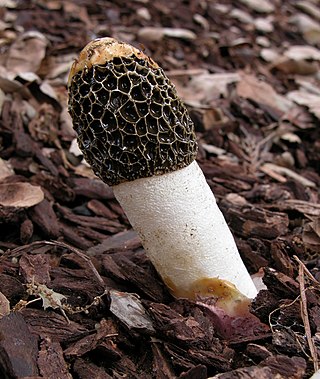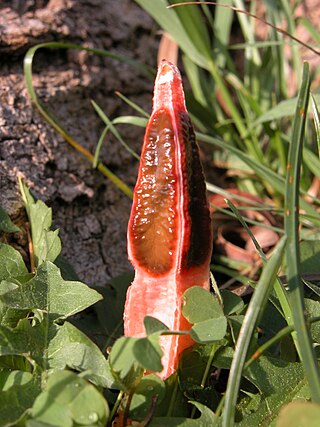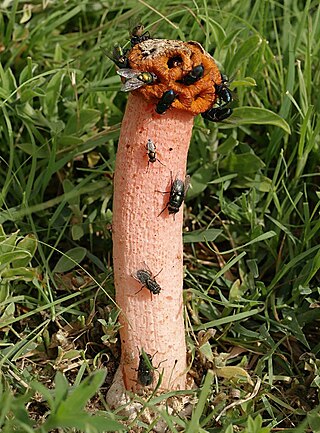
Puffballs are a type of fungus featuring a ball-shaped fruit body that bursts on contact or impact, releasing a cloud of dust-like spores into the surrounding area. Puffballs belong to the division Basidiomycota and encompass several genera, including Calvatia, Calbovista and Lycoperdon. The puffballs were previously treated as a taxonomic group called the Gasteromycetes or Gasteromycetidae, but they are now known to be a polyphyletic assemblage.

Phallaceae is a family of fungi, commonly known as stinkhorns, within the order Phallales. Stinkhorns have a worldwide distribution, but are especially prevalent in tropical regions. They are known for their foul-smelling, sticky spore masses, or gleba, borne on the end of a stalk called the receptaculum. The characteristic fruiting-body structure, a single, unbranched receptaculum with an externally attached gleba on the upper part, distinguishes the Phallaceae from other families in the Phallales. The spore mass typically smells of carrion or dung, and attracts flies, beetles and other insects to help disperse the spores. Although there is great diversity in body structure shape among the various genera, all species in the Phallaceae begin their development as oval or round structures known as "eggs". The appearance of Phallaceae is often sudden, as gleba can erupt from the underground egg and burst open within an hour. According to a 2008 estimate, the family contains 21 genera and 77 species.

Phallus indusiatus, commonly called the basket stinkhorn, bamboo mushrooms, bamboo pith, long net stinkhorn, crinoline stinkhorn, bridal veil, or veiled lady, is a fungus in the family Phallaceae, or stinkhorns. It has a cosmopolitan distribution in tropical areas, and is found in southern Asia, Africa, the Americas, and Australia, where it grows in woodlands and gardens in rich soil and well-rotted woody material. The fruit body of the fungus is characterised by a conical to bell-shaped cap on a stalk and a delicate lacy "skirt", or indusium, that hangs from beneath the cap and reaches nearly to the ground. First described scientifically in 1798 by French botanist Étienne Pierre Ventenat, the species has often been referred to a separate genus Dictyophora along with other Phallus species featuring an indusium. P. indusiatus can be distinguished from other similar species by differences in distribution, size, color, and indusium length.

The genus Phallus, commonly known as stinkhorns, is a group of basidiomycetes which produce a phallic, often foul-scented mushroom, from which their name is derived. The genus has a widespread distribution and, according to a 2008 estimate, contains 18 species. They belong to the family Phallaceae in the order Phallales. The best known species is the common stinkhorn.

Phallus ravenelii, commonly known as Ravenel's stinkhorn, is a fungus in the Phallaceae (stinkhorn) family. It is found in eastern North America. Its mushrooms commonly grow in large clusters and are noted for their foul odor and phallic shape when mature. It is saprobic, and as such it is encountered in a wide variety of habitats rich in wood debris, from forests to mulched gardens or sawdust piles in urban areas. It appears from August to October. The fruit body emerges from a pink or lavender-colored egg to form a tall, cylindrical, hollow and spongy white stalk with a bell-shaped cap. The remains of the egg persist as a white to pink or lilac volva at the base of the stalk. The cap is covered in a foul-smelling olive-green spore slime, which attracts insects that help to spread the spores. Sometimes, the cap has a "veil" attached—a thin membrane that hangs underneath. The lack of a roughly ridged and pitted cap differentiates it from the closely related Phallus impudicus. The fungus is named after Henry William Ravenel, a botanist who first discovered it in 1846, though it remained undescribed until 1873. It is considered to be an edible mushroom while in its egg form.

Phallus duplicatus is a species of fungus in the stinkhorn family. The bell-shaped to oval cap is green-brown and the cylindrical stalk is white. When mature, the cap becomes sticky with a slimy green coating, which attracts flies that disperse its spores, and a distinct, "netted" universal veil. It often grows in public lawns, and can also be found in meadows. The fungus is edible when still in the "egg" stage, before the fruit body has expanded.

Phallus hadriani, commonly known as the dune stinkhorn or the sand stinkhorn, is a species of fungus in the Phallaceae (stinkhorn) family. The stalk of the fruit body reaches up to 20 cm (8 in) tall by 4 cm thick, and is spongy, fragile, and hollow. At the top of the stem is a ridged and pitted, thimble-like cap over which is spread olive-colored spore slime (gleba). Shortly after emerging, the gleba liquefies and releases a fetid odor that attracts insects, which help disperse the spores. P. hadriani may be distinguished from the similar P. impudicus by the presence of a pink or violet-colored volva at the base of the stem, and by differences in odor.

Phallus rubicundus is a species of fungus in the stinkhorn family. First described in 1811, it has a wide distribution in tropical regions. It has the typical stinkhorn structure consisting of a spongy stalk up to 15 cm (5.9 in) tall arising from a gelatinous "egg" up to 3 cm (1.2 in) in diameter. Atop the stalk is a pitted, conical cap that has a foul-smelling, gelatinous, green spore mass spread over it.

Mutinus caninus, commonly known as the dog stinkhorn, is a small thin, phallus-shaped woodland fungus, with a dark tip. It is often found growing in small groups on wood debris, or in leaf litter, during summer and autumn in Europe, Asia, and eastern North America. It is not generally considered edible, although there are reports of the immature 'eggs' being consumed.

Clathrus ruber is a species of fungus in the family Phallaceae, and the type species of the genus Clathrus. It is commonly known as the latticed stinkhorn, the basket stinkhorn, or the red cage, alluding to the striking fruit bodies that are shaped somewhat like a round or oval hollow sphere with interlaced or latticed branches. The species was illustrated in the scientific literature during the 16th century, but was not officially described until 1729.

Lysurus mokusin, commonly known as the lantern stinkhorn, the small lizard's claw, or the ribbed lizard claw, is a saprobic species of fungus in the family Phallaceae. The fruit body consists of a reddish, cylindrical fluted stipe that is capped with several "arms". The arms can approach or even close in on each other to form a spire. The gleba—an olive-green slimy spore mass—is carried on the outer surface of the arms. The fruit body has an odor comparable to "fresh dog feces", "rotting flesh", or "sewage" when mature.

Lysurus periphragmoides, commonly known as the stalked lattice stinkhorn or chambered stinkhorn, is a species of fungus in the stinkhorn family. It was originally described as Simblum periphragmoides in 1831, and has been known as many different names before being transferred to Lysurus in 1980. The saprobic fungus has a pantropical distribution, and has been found in Africa, Asia, Australasia, and the Americas, where it grows on fertile ground and on mulch. The fruit body, which can extend up to 15 cm (5.9 in) tall, consists of a reddish latticed head placed on top of a long stalk. A dark olive-green spore mass, the gleba, fills the interior of the lattice and extends outwards between the arms. Like other members of the family Phallaceae, the gleba has a fetid odor that attracts flies and other insects to help disperse its spores. The immature "egg" form of the fungus is considered edible.

Pseudocolus fusiformis is a stinkhorn mushroom in the Phallaceae, a family well known for a remarkable range of fruit body types. It is commonly known as the stinky squid, because of its fetid odor, and its three or four upright "arms" which are connected at the top. The malodorous smell comes from the dark greenish slimy gleba covering the inside faces of the arms, and attracts insects that help to disperse the spores.

Clathrus columnatus, commonly known as the column stinkhorn, is a saprobic species of basidiomycete fungus in the family Phallaceae. Similar to other stinkhorn fungi, the fruiting body, known as the receptaculum, starts out as a subterranean "egg" form. As the fungus develops, the receptaculum expands and erupts out of the protective volva, ultimately developing into mature structures characterized by two to five long vertical orange or red spongy columns, joined at the apex. The fully grown receptaculum reaches heights of 8 cm tall. The inside surfaces of the columns are covered with a fetid olive-brown spore-containing slime, which attracts flies and other insects that help disseminate the spores.

Calbovista is a fungal genus containing the single species Calbovista subsculpta, commonly known as the sculptured puffball, sculptured giant puffball, and warted giant puffball. It is a common puffball of the Rocky Mountains and Pacific Coast ranges of western North America. The puffball is more or less round with a diameter of up to 15 cm (6 in), white becoming brownish in age, and covered with shallow pyramid-shaped plates or scales. It fruits singly or in groups along roads and in open woods at high elevations, from summer to autumn.

Mutinus elegans, commonly known as the elegant stinkhorn, the dog stinkhorn, the headless stinkhorn, or the devil's dipstick, is a species of fungus in the Phallaceae (stinkhorn) family. The fruit body begins its development in an "egg" form, resembling somewhat a puffball partially submerged in the ground. As the fungus matures, a slender orange to pink colored stalk emerges that tapers evenly to a pointed tip. The stalk is covered with a foul-smelling slimy green spore mass on the upper third of its length. Flies and other insects feed upon the slime which contains the spores, assisting in their dispersal.

Agaricus deserticola, commonly known as the gasteroid agaricus, is a species of fungus in the family Agaricaceae. Found only in southwestern and western North America, A. deserticola is adapted for growth in dry or semi-arid habitats. The fruit bodies are secotioid, meaning the spores are not forcibly discharged, and the cap does not fully expand. Unlike other Agaricus species, A. deserticola does not develop true gills, but rather a convoluted and networked system of spore-producing tissue called a gleba. When the partial veil breaks or pulls away from the stem or the cap splits radially, the blackish-brown gleba is exposed, which allows the spores to be dispersed.

Phallus calongei is a species of stinkhorn mushroom. Found in Pakistan, it was described as new to science in 2009. Starting out as an "egg", the fully expanded fruit body consists of a single, thick, stipe with a cap attached to the apex and covered with olive-green, slimy spore-containing gleba. It is distinguished from other similar Phallus species by a combination of features, including a pinkish, reticulated (network-like) cap, and a stipe that is tapered at both ends. The edibility of the mushroom is unknown.

Colus hirudinosus is a species of stinkhorn fungus (Gasteromycete) found in Asia, Australia, northern Africa, and southern Europe. The fruit body has a short, thick stalk that divides into several spongy, wrinkled, stalk-like, orange to red columns that are united at the top, thus forming a lattice. The spores are found within the gleba—a dark, olive-brown slime that coats the inside of the columns. Spores are spread by insects that are attracted by the fetid smell of the gleba, eat the spores, and pass them on to germinate elsewhere.

Scleroderma polyrhizum, commonly known as the star earthball or dead man's hand, is a basidiomycete fungus and a member of the genus Scleroderma, or "earthballs". Found in dry, sandy soils, this species begins completely buried before slowly forcing the soil aside as it cracks apart to form a rough, star-shaped body with a diameter of 12–15 cm (4.7–5.9 in). At the center is the dark, brownish spore mass. Widely distributed wherever the soil and climate are favorable, it is known from Asia, Europe, and the Americas.





















